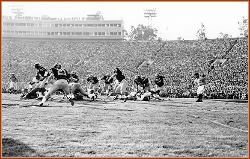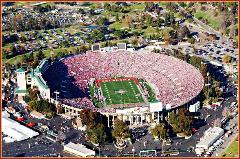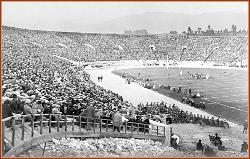Beautiful Floyd Casey Stadium is in its 56th season as home to the Baylor football team.
The stadium is continually upgraded to give Baylor a facility necessary to be competitive
in the Big 12 Conference.
New in 2006 is a tribute to Baylor football around the stadium designed to enhance the
Grant Teaff Plaza, which includes the Letterwinners Plaza and the "I Believe" Walkway. A
new recruiting center, located on the northwest patio, also opened prior to the 2006
season.
The plaza, first opened in 2002, originally was located at the base of the press box on the
west side of the stadium. The plaza has since been expanded to wrap completely around
the stadium. The plaza's centerpiece is a statue honoring former Baylor head coach and
College Football Hall of Fame member Grant Teaff, the program's winningest coach who
led Baylor to two Southwest Conference titles.


In 2004, Baylor unveiled a new synthetic turf playing surface after six seasons of play on SportGrass. The natural surface was replaced with the
Prestige System playing surface.
In 2002, Baylor added a 23-by-31-foot LED video screen going in the south end zone. The project included the addition of a state-of-the-art
sound system and new digital scoreboards in both end zones.
Baylor's locker room got a face lift in 2001, when the $2 million facility, the Big 12's largest, was completed.
Baylor added a state-of-the-art luxury suite and pressbox structure on the stadium's west side in 1999. One year prior, the team meeting room
area also underwent a complete remodeling.
In 1990, new lights, expanded and improved restrooms, and new concession stands were completed.
The Carl and Thelma Casey Athletic Center houses departmental offices, locker rooms, training rooms, weight facilities, a video studio and
meeting facilities. The state-of-the-art facility was opened in 1991.
After 39 years of being called Baylor Stadium, 1989 was the stadium's first full year under the name Floyd Casey Stadium.
The name change officially took place during halftime ceremonies of the 1988 Homecoming game with Arkansas when it was announced that
longtime University supporter and trustee the late Carl B. Casey of Dallas and his wife, Thelma, contributed $5 million to the stadium renovation
project in honor of his father Floyd Casey. The generous Casey donation was part of an $8 million campaign.
After World War II the Baylor Stadium Corporation was formed and began a campaign to build a stadium for the University. The corporation
launched a bond sales program and was able to raise $1.5 million for construction costs. The Bears moved to Baylor Stadium in 1950.
The first game played in the 50,000-seat stadium was Sept. 30, 1950, a 34-7 Baylor victory over the Houston Cougars, then, an independent
team. The initial Southwest Conference game was Nov. 4, 1950, a 27-20 win over Texas A&M. The largest crowd to see at home was the 2006
A&M game when 51,385 fans jammed the stadium to watch the Aggies top the Bears 31-21.
From 1972 to 1997, the Bears played on an AstroTurf surface at Floyd Casey Stadium.
During the 1970s, the beautiful and comfortable Letterman's Lounge was built on the stadium's west side with funds provided by former athletes.
That facility received a facelift in 1995.
An eight-year project to change from worn wooden to modern aluminum bleacher was finished in 1981.
Prior to the building of Baylor Stadium in 1950, several playing sites were employed by the Bears. The first Bear football squad was formed in
1899, but no records are available to prove where the team played. Old newspaper clippings and yearbook articles only indicate the first three
seasons were played on an extremely rough field close to the school.
From 1902 to 1925, with the exception of 1906 when football was banned on campus because it was deemed too violent, the Bears played most
of their games at Carroll Field, an on-campus facility.
An unknown number of games were played at the old Cotton Palace during this period. The Bears played at the Cotton Palace from 1926-29
before returning to Carroll Field from 1930-35.
The team moved off the main campus for good in 1936 when it began calling the newly built Waco Stadium home. Waco Stadium was renamed
Municipal
Stadium in 1942, and it was where BU played through 1949 except for a break from 1943-44 because of the war effort.






